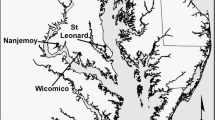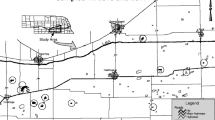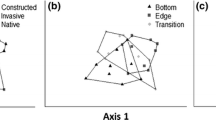Abstract
It is often presumed plant recruitment from the soil seed bank and nearby wetlands will be sufficient to establish a wetland plant community following the restoration or creation of wetland hydrology. This approach to wetland restoration was examined in four compensatory wetlands and a natural oxbow wetland (Oxbow) in a floodplain of the West Fork Trinity River in north-central Texas. We assessed: (1) similarities in vegetation and seed bank composition among natural and compensatory wetlands, (2) within site similarity of vegetation relative to its seed bank community, and (3) the effects of hydrology (Wet vs. Drained soil) on the germination of seeds from the seed bank. Species richness of the standing vegetation was variable across sites and years, however when pooled across years (2008–2009) vegetation and seed banks showed similar species richness (66 vs. 70 species). Fewer wetland species (i.e., species occurring in wetlands >50 % of the time) were observed in the vegetation relative to the seed bank (25 vs. 41 species), and seed banks of compensatory wetlands were more similar to the natural wetland than was the standing vegetation. In the seed bank study, location (i.e., site) significantly affected total species richness, wetland species richness, diversity, and germinated seeds m−2, however no significant effect of hydrology was detected. These results suggest hydrology alone is not sufficient to establish a desired wetland plant community in a created wetland and the inclusion of seed bank surveys with field vegetation surveys provides a more complete assessment of wetland creation and restoration.




Similar content being viewed by others
References
Aronson MFJ, Galatowitsch S (2008) Long-term vegetation development of restored prairie pothole wetlands. Wetlands 28:883–895
Baldwin AH, DeRico EF (1999) The seed bank of a restored tidal freshwater marsh in Washington, D.C. Urban Ecosystems 3:5–20
Baldwin AH, Egnotovich MS, Clarke E (2001) Hydrological change and vegetation of tidal freshwater marshes: field, greenhouse, and seed-bank experiments. Wetlands 21:519–531
Brinson MM, Rheinhardt R (1996) The role of reference wetlands in functional assessment and mitigation. Ecol Appl 6:69–76
Brown SC (1995) Wetland restoration: factors controlling plant community response and avifaunal habitat value. Dissertation, Cornell University
Brown SC (1998) Remnant seed banks and vegetation as predictors of restored marsh vegetation. Can J Botany 76:620–629
Brown SC, Bedford BL (1997) Restoration of wetland vegetation with transplanted wetland soil: an experimental study. Wetlands 17:424–437
Collins DP, Conway WC, Mason CD, Gunnels JW (2013) Seed bank potential of moist-soil managed wetlands in east-central Texas. Wetlands Ecol Manage 21:353–366
Dahl TE (1990) Wetland losses in the United States 1780’s to 1980’s. U.S. Department of the Interior, Fish and Wildlife Service, Washington, DC, 13 pp
De Steven D, Sharitz RR, Singer JH, Barton CD (2006) Testing a passive revegetation approach for restoring coastal plain depression wetlands. Restor Ecol 14:452–460
Diggs GM, Lipscomb BL, O’Kennon RJ (1999) Shinner and Mahler’s illustrated Flora of North Central Texas. Botanical Research Institute of Texas, Fort Worth
Enwright N, Hudak PF, Hatley D (2011) Estimating inundation patterns in detention wetlands: methodology and application to North-Central Texas. Int J Environ Stud 68:61–71
Ficken CD, Menges E (2013) Seasonal wetlands on the Lake Wales Ridge, Florida: does a relict seed bank persist despite long term disturbance? Wetlands Ecol Manage 21:373–385
Fraser LH, Karnezis JP (2005) A comparative assessment of seedling survival and biomass accumulation for fourteen wetland plant species grown under minor water-depth differences. Wetlands 25:520–530
Fredrickson LH, Taylor TS (1982) Management of seasonally flooded impoundments for wildlife. United States Fish and Wildlife Service, Resource Publication 148
Galatowitsch SM (2006) Restoring prairie pothole wetlands: does the species pool concept offer decision-making guidance for re-vegetation. Appl Veg Sci 9:261–270
Galatowitsch SM, van der Valk AG (1996) The vegetation of restored and natural prairie wetlands. Ecol Appl 6:102–112
Greet J, Cousens RD, Webb JA (2013) Flow regulation is associated with riverine soil seed bank composition within an agricultural landscape: potential implications for restoration. J Veg Sci 24:157–167
Haukos DA, Smith LM (1993) Moist-soil management of playa lakes for migrating and wintering ducks. Wildl Soc Bull 21:288–298
Hobbs RJ, Mooney HA (1995) Spatial and temporal variability in California annual grassland: results from a long-term study. J Veg Sci 6:43–56
La Grange TG, Dinsmore JJ (1989) Plant and animal community responses to restored Iowa wetlands. Prairie Naturalist 21:39–48
Leck MA, Leck CF (2005) Vascular plants of a Delaware River tidal freshwater wetland and adjacent terrestrial areas: Seed bank and vegetation comparisons of reference and constructed marshes and annotated species list. J Torrey Bot Soc 132:323–354
Leck MA, Simpson RL (1987) Seed bank of a freshwater tidal wetland: turnover and relationship to vegetation change. Am J Bot 74:360–370
Madsen C (1986) Wetland restoration: a pilot project. J Soil Water Conserv 41:159–160
Mitsch WJ, Gosselink JG (2000) The value of wetlands: importance of scale and landscape setting. Ecol Econ 35:25–33
Mitsch WJ, Wu X, Nairn RW, Weihe PE, Want N, Deal R, Boucher CE (1998) Creating and restoring wetlands. Bioscience 48:1019–1029
National Oceanic and Atmospheric Administration (NOAA) (2013) Monthly station normals of temperature, precipitation, and heating and cooling degree days. 1971–2012. http://cdo.ncdc.noaa.gov. Accessed 8 August 2013
Peterson JE, Baldwin AH (2004) Seedling emergence from seed banks of tidal freshwater wetlands: response to inundation and sedimentation. Aquat Bot 78:243–254
Smith LM, Kadlec JA (1983) Seed banks and their role during drawdown of a North American marsh. J Appl Ecol 20:673–684
Smith SM, McCormick PV, Leeds JA, Garrett PB (2002) Constraints of seed bank species composition and water depth for restoring vegetation in the Florida Everglades, USA. Restor Ecol 10:138–145
Sørensen T (1948) A method for establishing groups of equal amplitude in plant sociology based on similarity of species content and its application to analyses of the vegetation on Danish commons. Biologiske Skrifter/Kongelige Danske Videnskabernes Selskab 5:1–34
Thompson K, Grime JP (1979) Seasonal variation in the seed banks of herbaceous species in ten contrasting habitats. J Ecol 67:893–921
United States Army Corps of Engineers (USACE) (2002) National wetlands mitigation action plan, 5 pp
United States Army Corps of Engineers Environmental Laboratory (USACE) (1987) Corps of Engineers wetlands delineation manual. Technical report Y-87-1. United States Army Engineer Waterways Experiment Station, Vicksburg
United States Department of Agriculture (USDA) National Resource Conservation Service plant database (2010) National Plant Data Center, Baton Rouge. http://plants.usda.gov. Accessed 25 October 2010
van der Valk AG (1981) Succession in wetlands: a Gleasonian approach. Ecology 62:688–696
van der Valk AG (2013) Seed banks of drained floodplain, drained palustrine, and undrained wetlands in Iowa, USA. Wetlands 33:183–190
van der Valk AG, Davis CB (1978) The role of seed banks in the vegetation dynamics of prairie glacial marshes. Ecology 59:332–335
van der Valk AG, Penderson RL (1989) Seed banks and the management and restoration of natural vegetation. In: Leck MA, Parker VT, Simpson RL (eds) Ecology of soil seed banks. Academic Press Inc, San Diego, pp 329–346
van der Valk AG, Rosburg TR (1997) Seed bank composition along a phosphorous gradient in the northern Florida Everglades. Wetlands 17:228–236
Whigham D, Pittek M, Hofmockel KH, Jordan T, Pepin AL (2002) Biomass and nutrient dynamics in restored wetlands on the coastal plain of Maryland, USA. Wetlands 22:562–574
Zedler JB (2000) Progress in wetland restoration ecology. Trends Ecol Evol 10:402–407
Acknowledgments
We thank T. Green, B. Hunter, R. Marusak, J. Snow, A. Turley, M. J-T. Wall and M. L. Wall, M. Wellner, P. Curry, N. Enwright, P. Redfearn and D. Wilson at the City of Grand Prairie, Texas, and the University of North Texas Institute of Applied Science, and two anonymous reviewers that provided comments which improved an earlier draft of this paper. Funding was provided by the city of Grand Prairie, Texas.
Author information
Authors and Affiliations
Corresponding author
Rights and permissions
About this article
Cite this article
Wall, C.B., Stevens, K.J. Assessing wetland mitigation efforts using standing vegetation and seed bank community structure in neighboring natural and compensatory wetlands in north-central Texas. Wetlands Ecol Manage 23, 149–166 (2015). https://doi.org/10.1007/s11273-014-9366-2
Received:
Accepted:
Published:
Issue Date:
DOI: https://doi.org/10.1007/s11273-014-9366-2




